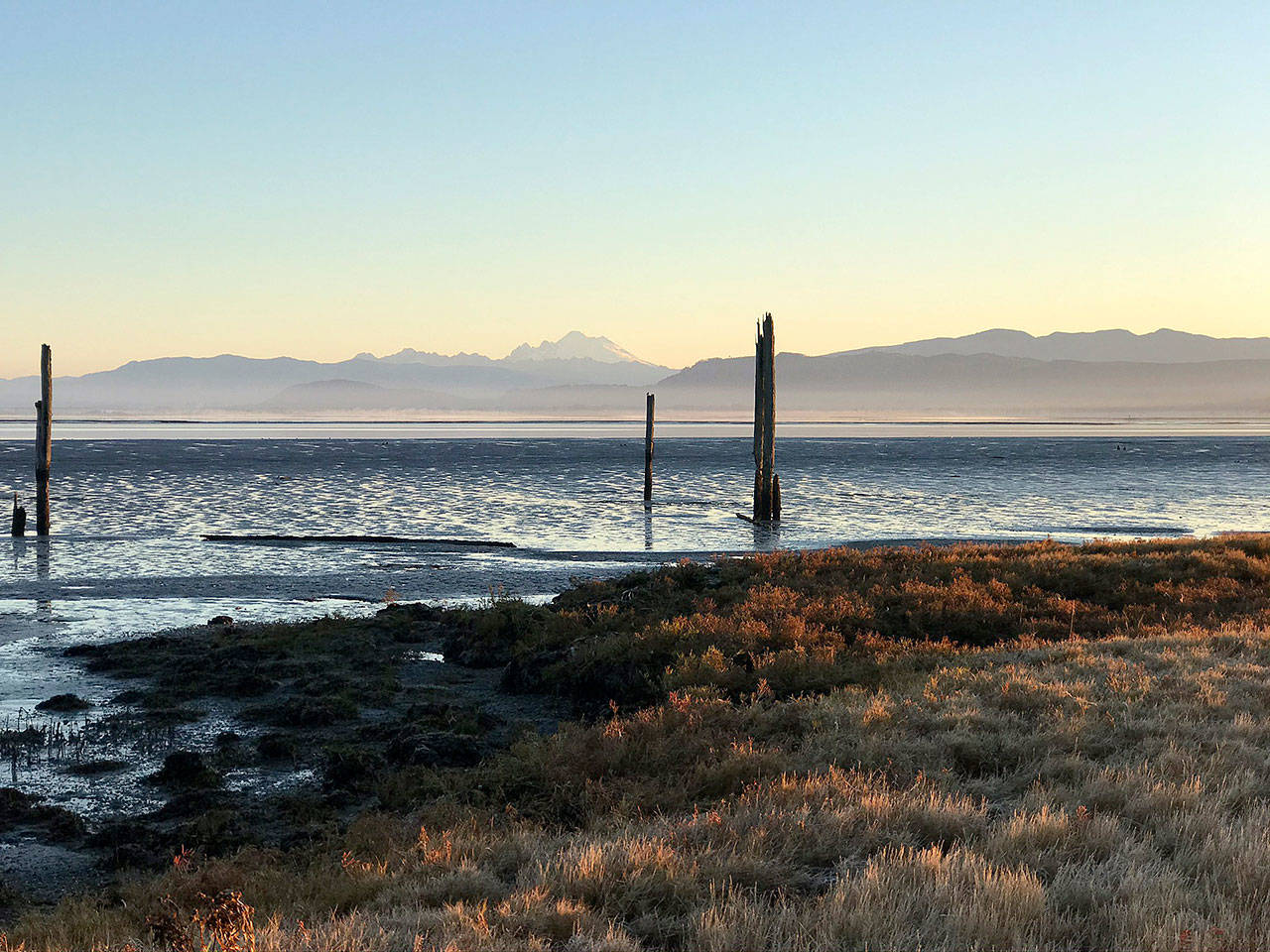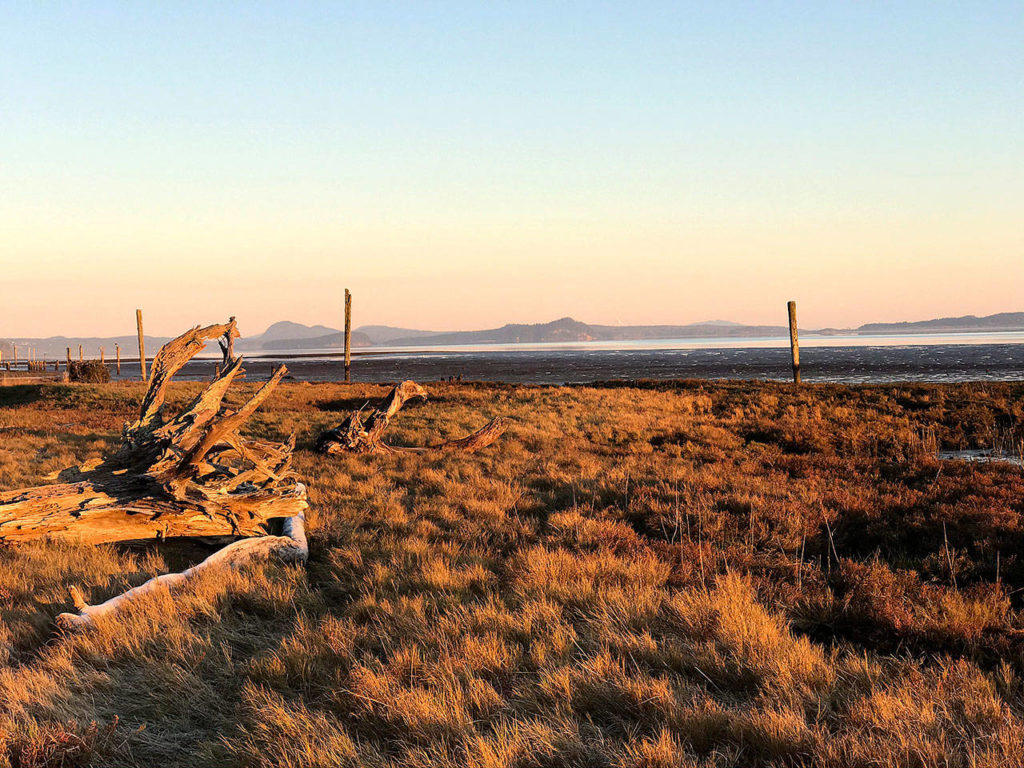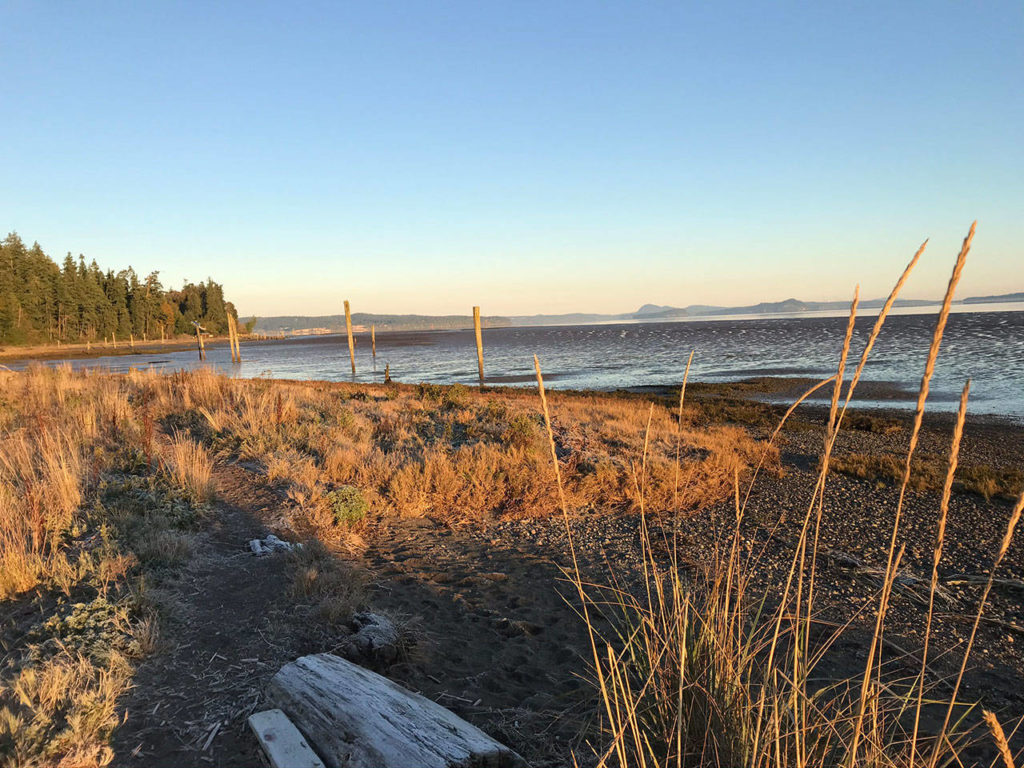CAMANO ISLAND — In the 1920s and ’30s, the bounty of the virgin forest east of Stanwood and Mount Vernon wound up at English Boom, a bustling operation at the island’s north end.
Nearly 75 years later, the desiccated skeleton of the boom clings to a lonesome expanse of tide flats on Skagit Bay. Hundreds of decaying pilings are all that’s left of a log yard that stored up to 15 million board feet of timber at a time — enough to build 1,500 homes.
Thanks to the efforts of Friends of Camano Island Parks, Island County acquired the property that became English Boom Historical Park in 1997. It was the first park on Camano Island that was purchased with Island County Conservation Futures money.
The 6-acre park is modest: a parking area with space for perhaps a dozen cars, a picnic shelter, some interpretive signage and a short trail across a salt marsh. The beauty of the place, however, is not modest. It’s a great place for birdwatching, or just enjoying a quiet stroll. Unless U.S. Navy jets are drilling overhead, birdsong and the occasional distant train horn from across the bay are pretty much the only things you’ll hear.
Because the park faces north, it’s sheltered from the prevailing southeasterly gales of winter. It would be a fine place to visit on a sunny winter afternoon.
Dogs are allowed to run off-leash on the 900 feet of beach, but not in the salt marsh. Dog owners should take note that tidelands west of the parking area and picnic shelter are private.
What’s the story behind this place? Here’s what historical records say.
English Boom was named for Edward G. English, one of the Puget Sound area’s preeminent timber barons of the late 19th and early 20th centuries.
Born in 1850 in Massachusetts, English came west in his 20s, eventually winding up in Skagit County, where he was one of the founders of Mount Vernon. He eventually became president not only of English Logging Co., but also of companies with mills in Seattle, Everett and Vancouver, B.C., among other places. This was an era when the timber industry was king of the Northwest economy.
Timber harvested at English Logging Co. camps in the foothills was hauled by rail, on an elaborate system of train tracks built specifically for logging, to a yard at Milltown, a long-gone community near the mouth of the Skagit River’s south fork. There, the logs were sorted, graded, lashed together into rafts and towed down the river and across the bay by shallow-draft tugboats to English Boom.
About 20 men, many of them immigrants or the sons of immigrants, worked at the boom. Shod in spike-soled boots, they used tools called pike poles to corral the logs as needed before the rafts towed to their final destinations: sawmills in waterfront cities such as Everett, Marysville and Edmonds.
Managed by Martin Tjerne of Stanwood, the boom had cabins, bunkhouses and a cookhouse that floated alongside the log rafts. A 145-foot passenger sternwheeler, the former S.G. Simpson, was acquired by Tjerne in 1928, converted into a workboat and renamed the E.G. English. It was fitted with a dredger to plow navigable channels in the mudflats, and occasionally hauled logs to a mill in Stanwood.
The boom’s namesake died in 1930. All of English’s mills and camps closed the day of his funeral. He left behind a million-dollar estate and a mansion near Volunteer Park in Seattle.
The log boom that bore his name continued for another 15 years. But before long, the nearby virgin forest was depleted. Logging moved farther inland, and roads were built deep into the mountains for trucks to haul the logs to mills.
Having taken 2.5 billion board feet of timber out of the foothills, the English Logging Co. was sold in 1944 to the Puget Sound Pulp and Timber Co., which later was acquired by Georgia-Pacific Corp.
English Boom was closed in 1945. The E.G. English was stripped of its machinery and left to rot on the beach. The U.S. Army Corps of Engineers eventually towed the hulk across the bay to the mouth of the Skagit, where it became part of a dike.
A photo taken 45 years ago shows the remains of a large pier that once supported an oil tank at English Boom. Today, only rotted stubs remain of the pier.
Forty-five years from now, it seems likely that all the ghostly remains of English Boom will be gone, with only the park kiosk memorializing what once stood here.
If you go
English Boom Historical Park is located at the end of Moore Road on north Camano Island. Take Highway 532 west from Stanwood. Turn right on Good Road and drive north. Turn left on Utsalady Road, and watch for Moore Road on the right in about 1 mile, near the airfield. The park is open during daytime hours only. For more information, go to islandcountywa.gov/PublicWorks/Parks/Pages/english-boom.aspx.
Talk to us
> Give us your news tips.
> Send us a letter to the editor.
> More Herald contact information.





























